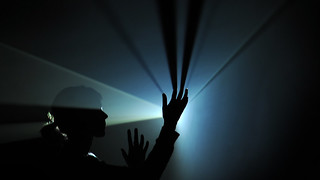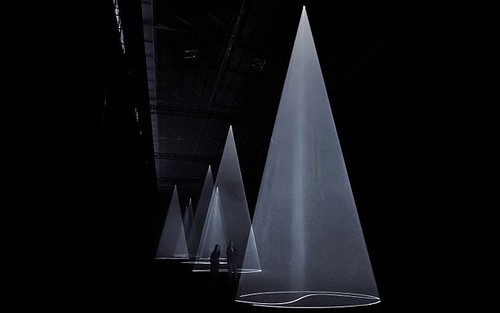Having set my sights on the aspect of purging, involving both myself and the audience, I tested out my Andre Stitt inspired performance idea.

Picture taken 08/03/2013 by Angela Graham
Unfortunately, covering myself in a substance (which ended up being tomato ketchup – as can be seen above) was not as successful as I would have liked, and I decided that it did not fit well with the logistics of the entire performance in the house.
Since then, I have explored the work of other performance artists who explore the idea of purging and/ or audience involvement.
Adrian Howells work, while not directly described as purging, deals with confession – which is, in a way, a cleansing for the soul. As a matter of fact, as we see in the above video, one of his performances is actually called Foot Washing For The Sole. In this performance he washes and massages an audience member’s feet while partaking in a confessional exchange with them. In much the same way, in another of his performances, known as Salon Adrienne, he dresses in drag (which he explains – or confesses – makes him feel more comfortable in his own skin) within a hair salon and performs as the audience members hair dresser while conversing with them in a manner that one would not normally with a stranger but perhaps with a friend, confessing and encouraging them to confess to him things about themselves to him.
This idea of spending time with a stranger in a way that you would only usually do so with a close friend really rang true with a lot of exploration I had done and discussed within the bathroom. As Conan so eloquently put – What if you are just having a bath and you invite people in?
One thing that has remained in my head throughout all of my exploration and research has been that the bathroom is a private place. What we do in the bathroom, we generally don’t do in front of anyone. But even if there are people we do it in front of – it is close family or lovers. All along I have seen this privacy as an almost sacred thing and the idea of anyone invading it as somehow dangerous or perverted. However, inspired by Howells’ practises, I have come to look at it from another angle. Inviting a stranger into this private space is sharing something intimate with them; it evokes and highlights the importance and gratification of human interaction. Without trying to be corny, there is actually something quite beautiful about it. Undeniably, it would be frightening, for both audience member and performer, but that fear and overcoming it together adds to what it would achieve.
 |
| http://totaltheatrereview.com/sites/default/files/imagecache/l_any/reviews/adrian-howells-pleasure-being.jpg |
Another aspect of Howell’s work which stands out as appropriate to my bathroom piece, is that it is one to one – as can be seen in the above picture of his performance, The Pleasure of Being: Washing, Feeding, Holding. This “shift in the traditional performer/spectator divide” ((Heddon D, Iball H, Zerihan R. ‘Come Closer: Confessions of Intimate Spectators in One to One Performance’, Contemporary Theatre Review. February 2012;22(1) pp. 120-133.)) before anything else, almost automatically makes the performance an interactive one. It turns “the audience’s role into one that receives (and) responds” ((Heddon D, Iball H, Zerihan R. ‘Come Closer: Confessions of Intimate Spectators in One to One Performance’, Contemporary Theatre Review. February 2012;22(1) pp. 120-133.)) much more directly, and “is actively solicited, engendered as a participant” ((Heddon D, Iball H, Zerihan R. ‘Come Closer: Confessions of Intimate Spectators in One to One Performance’, Contemporary Theatre Review. February 2012;22(1) pp. 120-133.)). As I said previously, audience involvement in my piece is something I want. And although previously I was perhaps looking at having two audience members at a time (which may have worked just fine with the Adrian Stitt inspired idea), having explored Howells’ work, I feel that being one to one with each audience member that sees my piece would be much more effective. The intimacy that is created in is performances, largely due to them being one to one, is the kind of intimacy I wish to create in my bathroom.
The performance shown in the above picture – The Pleasure of Being: Washing, Feeding, Holding – was actually done in a hotel bathroom. Interestingly, it is the first piece of performance art in a bathroom that I have managed to find at all, so I was quite excited to read about it. The bathroom was set up with “a bath full of bubbles and rose petals, candles in glass jars” ((Prior, D (2011)’ Adrian Howells: The Pleasure of Being: Washing, Feeding, Holding’ Total Theatre Review, 22 August, accessed 20 March 2013, http://totaltheatrereview.com/reviews/pleasure-being-washing-feeding-holding)) which is just how intend to decorate my bathroom. I want to create that inviting, warm and relaxing atmosphere. I want the audience member to enjoy being there, despite how awkward a situation it is in reality. In her review, Dorothy Max Prior compares the bathroom scene in Howells’ performance to somewhere you would spend “an assignation with a new lover” ((Prior, D (2011)’ Adrian Howells: The Pleasure of Being: Washing, Feeding, Holding’ Total Theatre Review, 22 August, accessed 20 March 2013, http://totaltheatrereview.com/reviews/pleasure-being-washing-feeding-holding)), which goes back to what I have been saying all along – if there is anyone you would allow to see you in the bath, it would be close family or a lover. This is exactly the scene I want to create… and then invite a stranger in.
There is a key difference however, between what Howells’ piece involved and what mine will. As the performer, Howells puts the audience member in the bath, pampers and bathes them. I, on the other hand, intend the flip this around, in that I will be the one in the bath; I will be the one in the vulnerable and private situation and I will ask the audience member to help wash me. I am choosing to do it this way partly because my performance is merely part of a larger collective performance and I must always bare this in mind, so to let the audience know they may have to bring swim wear specifically for my part of the performance would be quite difficult (and the likelihood of many audience members willingly getting naked is remote). I am, however, also choosing to do it this way because of the importance of the room in my performance by comparison to Howells’. The bathroom and what it means to us is something I need and want to get across (as our performance is about home) and I think, for the audience member to walk in on someone bathing as they usually would in the comfort of their own home, relates to and represents this more than treating them as though they are at a spa day.



